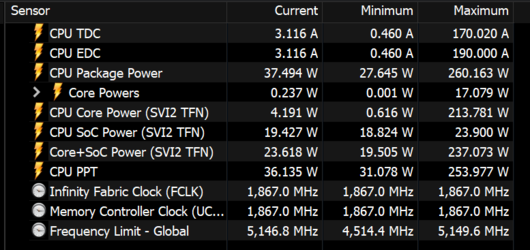I see it in my tests on multiple CPUs and motherboards. Since the declared clock isn't a static value, you have to test it on a specific test platform to find out how it acts. When you run 13700k/14700k, it will show around 3.5-4GHz at an extended high load because it will be limited to 125W. When you run 7800X3D in the same workloads, it will show 5.05GHz all the time and below the power limit (mentioned 88W instead of 120W)... as long as the CPU temp is ~85°C. 7950X or higher X3D will randomly boost 1-2 cores up to their max clock in extended high load (out of the extended power limit window).
It depends on how you interpret throttling, since that is intentional behaviour. If you have a 253W short term power limit for example, it is normal and expected to see a power limit at that value. Likewise a long term limit to 125W. If you don't want to be power limited, you have to remove the power limits. But then you can still be limited due to thermal or current for example. There will be limits somewhere.
Intentional is a balance within a specified frequency window, so between a base clock and turbo/boost clock. Not below the base clock. Throttling is running at a speed below the declared base clock (or other value specified as default). In short, if you have a CPU like 14700K and it drops under 3.4GHz on even a single core, then it's throttling.
If you run diagnostic software like AIDA64 or hwinfo64, it will show you throttling, as it's a CPU-programmed state. I've never seen throttling on new AMD CPUs during regular work. They lower the frequency, but they are still much above the base clock. Intel CPUs show throttling quite often, even in extended mixed load tests.
X3D is a special case since they have to be intentionally limited out of the factory to avoid cooking the cache. Look at the non-3D equivalents to see how much they're limited. 7600 running ~85W sounds like it is on the PPT limiter? If PPT limit is increased does it go higher with sufficient load? (assuming other limiters don't activate)
The 7600 overclocked to 5.3GHz still has 90W, while the 7600 with everything unlocked keeps ~110W after OC. To make it run at a higher wattage, you have to set a higher voltage or lock the voltage at a higher value, but this doesn't help with overclocking, so it's pointless. At stock, it doesn't really matter if you unlock power limiters or not. It will show +/-5W under load.
7950X, as long as you can keep low enough temps, will boost above the specified values at ~170-180W. If you run extended high-load tests, then it will keep 140-150W and ~5.0-5.1GHz. If you do the same on any competitive Intel, they will drop to ~4GHz ~125-150W.
This is why I repeat that Intel added E-cores to compete with AMD in multithreaded tests, as without lower power cores, they can't really beat AMD in any rendering test or anything else that uses all the CPU cores. I guess it's easy to imagine what would be if Intel used 16-24 regular cores from 13/14th gen. Somehow AMD does that.
In games, they stick with 2 cores up to the max boost as numbers sell, and most games are still using only a few cores.
X3D is only frequency-locked, but it overclocks with bclk, and it's not a problem to push it for the next 300MHz+ if you have a motherboard with a separate bclk for the CPU. The only problem can be too high SOC voltage, but everything else can be set above the specs. SOC voltage was locked at the BIOS level a long time ago, and somehow then people noticed it's not really required above 1.25V.





